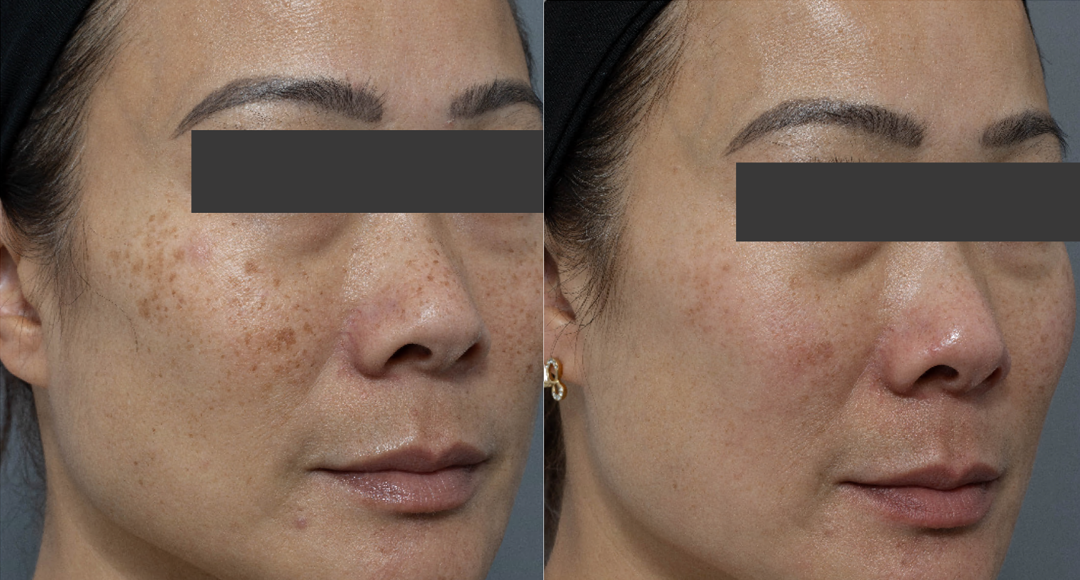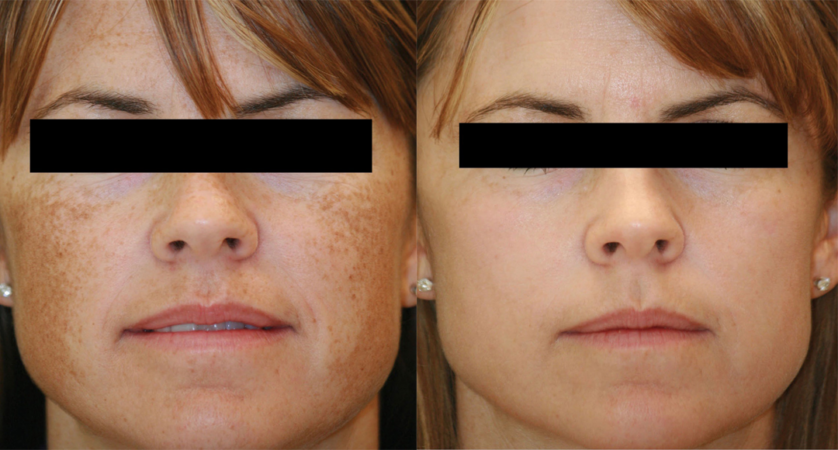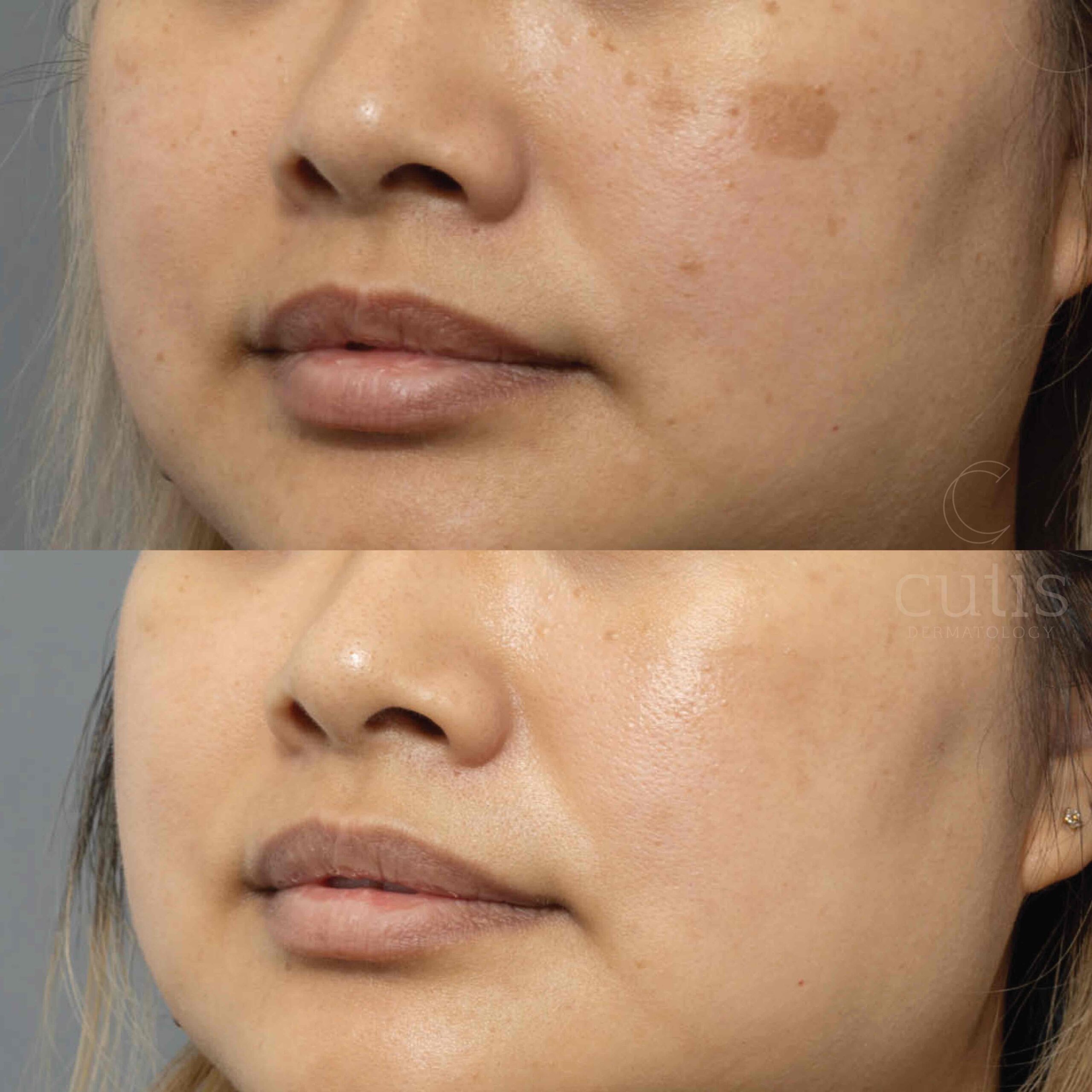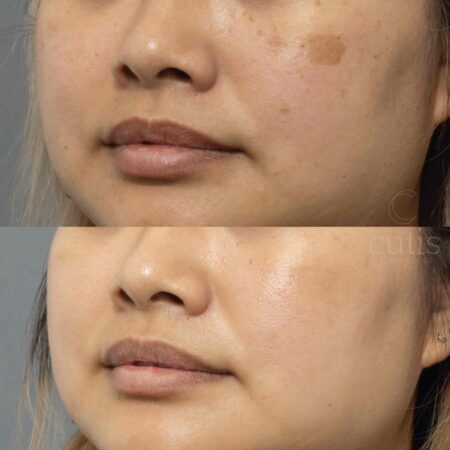Lasers are excellent for treating pigmentation. Our portfolio ranges from zero downtime procedures to skin resurfacing for highly sun-damaged skin. The procedure of choice depends on your goals & type of pigmentation you have.
Cutis Dermatology offers a variety of pigmentation treatment options:
- Fraxel Laser Resurfacing
- Picoway Laser
- Picosure Pro Laser
- Hybrid Laser Resurfacing
- Cosmelan Peels
- Dermal Toning Laser
- Pigmentation Skin Care
Our results speak for themselves

Before
After

Picoway using the 730 & 532 Fractional Resolve can markedly reduce pigmentation, including freckles.
Ask us more about this treatmant
Preferred Consultation

Before
After

Broad Band Light using pigment filters can markedly improve freckles in 1-2 sessions.
Ask us more about this treatmant
Preferred Consultation

Before
After

2 sessions of Pico laser.
Ask us more about this treatmant
Preferred Consultation
Treatments for Pigmentation
The path to successful & safe pigmentation treatment is a diagnosis.
Melasma Pigmentation
Our experts at Cutis Dermatology can distinguish between the causes of pigmentation & formulate a bespoke treatment plan consisting of lasers, clinical grade chemical peels & prescription topicals. To understand more about how to effectively treat pigment, schedule a FREE* nurse consultation at our Brisbane clinics.
*T&C applies.
Melasma pigmentation requires special treatments with the correct skin care, chemical peels & lasers. Treatments are directed at reducing pigment production. The first step in melasma treatment is to understand the level of pigmentation. Chemical peels can be used for superficial pigment, whilst lasers are better for mixed & deep pigmentation.
Pigment from acne & acne scarring
Pigmentation in Asian & ethnic skin types
PIH or post-inflammatory hyperpigmentation is commonly seen after acne. Patients with darker skin types are prone to developing this type of acne scarring. Cutting edge pico lasers such as the Picoway can effectively & safely erase pigment in a few sessions.
Pico lasers speed up pigment clearance by over 10 times as compared to normal lasers or chemical peels.
Experience, skill sets & equipment is the key to safe & effective pigment removal, especially when treating ethnic & Asian skin types. Cutis Dermatology has 2 pico lasers for removing pigment in darker skin, including the Picoway & Picosure Pro. A series of 2-4 sessions will markedly improve skin texture, pigment as well as fine lines & enlarged pores.
Topical creams are first line therapy for conditions such as melasma. The ingredients & concentration depends on the depth of pigment as well as your skin type & sensitivity.
FAQs
Why Cutis Dermatology?
Our dermatologists have over 20 years of clinical expertise in the field of aesthetic dermatology.
Combined with the latest in state-of-the-art laser technology, our team can address even the most complex cases to deliver unparalleled results. Our portfolio of over 35 laser devices covers the very latest vascular laser technology, including pulse dye lasers, 532 hybrid lasers & BBL.
What is the best treatment for melasma?
Melasma is a medical condition & should be treated by dermatologists. The best treatment depends on the type of melasma, namely the depth of pigmentation. As a guide we start off with pigment inhibitors & correctors, then move on to either a laser or chemical peel program. Lasers include Pico & Dermal Toning Q Switching.
What is the best treatment of age spots & dots?
Pigment due to age & sun are best removed with Hybrid laser resurfacing. This combines both Fraxel HD & CO2 lasers. In most cases only one session is required. Downtime approaches 5 days. Best for lighter skin types.
How do we approach freckles?
This is one of the easiest forms of pigment to treat, especially in lighter skin types. BBL photorejuvenation gives the best outcomes. Most only require 2 sessions.
Other things that can treat freckles include-
- Picoway or Picosure Pro laser
- Fraxel HD
- TCA peels
- IPL & Fraxel
What’s the best way to treat pigmentation on the body?
First, you must understand the concept of blending. See the even transition between the inner arm & your outer arm? Treatments are aimed at reducing the contrast between them. We do with with-
- BBL or IPL
- Fraxel
- Pico & Q switch lasers
Most patients require between 3-6 sessions for best results.
How do lasers compare to chemical peels?
It really depends on your type of pigmentation, your skin type or colour & your downtime. In most cases lasers are better than chemical peels, with the exception of-
- Superficial melasma, where Dermamelan acts faster than lasers
- Pigment & wrinkles in lighter skin types whereby Jessner TCA is better than Fraxel
Our peel portfolio includes Jessner, TCA, phenol, glycolic, lactic, mandelic, enzymatic, retinoic acid, & salicylic acid peels. Each chemical peel will have a specific indication.
What is the best laser for pigmentation in ethnic & Asians?
By far, the pico laser with Picoway & Picosure Pro. These lasers can treat superficial & deep pigment from all causes including sun, melasma, mixed pigment, birthmarks & Hori nevus.
Most patients require 2-4 pico laser sessions, recovery is within 12 to 24 hours for most cases.
What is the best solution for acne marks & pigmentation?
Your choices include chemical peels or pico lasers. Chemical peels include retinoic acid, glycolic & Jessner peels. The best laser for dark acne marks is Picoway. This laser clears up pigment 10 times faster than peels or skin care. Picoway-
- Reduces pigment within 2-3 sessions
- Has no recovery time
- Can be used in darker skin type
- Improves pores & superficial acne scars
What is pigmentation under my arms & how to treat it?
Underarm pigment is usually due to one of three things-
- Acanthosis nigricans; a condition that can respond to lasers, vitamin A & metformin.
- Post inflammatory hyperpigmentation, usually to anti-sweat products like deodorants. It’s fixed with anti-wrinkle injections & lasers.
Genetic. This is the hardest to treat, lasers can have marginal improvements.
How many sessions will it take?
The ideal number of treatments depends on the diagnosis, your skin type & goals. Our team will give you an accurate indication during the time of consultation. As a guide-
- Pigment such as age spots in lighter skin types: 1-2 sessions
- Pigment in darker skin types, Asian & ethnic: 2-4 sessions
- Melasma pigmentation: 2-5 sessions
- Post inflammatory for acne: 2-3 sessions
Why is microneedling a bad treatment for pigmentation?
Microneedling is an awesome treatment for hair loss & some forms of dermal scarring, however it is a really bad treatment for pigmentation. Microneedling frequently pushes pigment deeper in the skin, especially in cases of melasma. This results in deeper dermal pigmentation, which is much harder to treat.
At Cutis Dermatology we employ the correct treatment methods to treat a skin condition. We do not endorse one treatment that ‘can possibly do’ a multitude of things.
What pigment lasers are used to remove birthmarks?
Birthmarks such as Cafe Au Lait macules can be removed with either Q switch or pico lasers. If you have lighter skin, we go for nano Q switch, whilst darker skin types we opt for pico lasers. 2-3 treatments are required for removal.
Congenital moles or melanocytic nevi are not treated with lasers. They do best with surgical excision. The same applies to Becker nevus. If you have a port wine stain or a red birthmark, vascular lasers are used.
What is the best laser for Hori nevus pigmentation?
Nano or pico lasers do a good job with Hori nevus. Pico lasers offer a faster rate of clearance, whilst adding an extra level of safety. As a guide, it takes between 3-6 sessions over 6-12 months to achieve the best results.
What are the side effects of pigment removal?
Precisely applied pigment lasers & peels have very little side effects. The most common complication is paradoxical darkening of pigment. As a guide-
- Nano or Q Switch lasers – 15-20% of cases
- Pico lasers- 3% of cases (hence why we use pico)
- TCA peels or deep peels- 5-8% of cases
- Retinoic acid peels- 1% of cases
- Fraxel laser resurfacing- 5% of cases
If you are at risk of hyperpigmentation, our specialist will often initiate pigment correctors during the recovery period. They will guide you.
What is the best laser for dark circles?
Dark circles follow a very complex treatment algorithm. For pigment associated dark circles Picoway will give good results. For vascular associated dark circles pulse dye lasers can help.
For dark circles associated with volume loss, dermal fillers can make a good improvement with zero downtime.
What is the best skincare for pigmentation?
The biggest traction you will get is with proper use of sunscreen. Namely 2.5 ml twice a day, regardless of sun exposure. From there you can add-
- Retinol & ascorbic acid
- Arbutin
- Liquorice extracts
- AHAs & BHA exfoliating
- HQ or cysteamine
- Botanicals & azelaic acid
You will be guided as to the best combination for your type of pigment & depth. Book a FREE* nurse consultation at our Brisbane clinics. T&C applies.
How do I use vitamin C for pigmentation?
Vitamin C or ascorbic acid is a powerful pigment inhibitor. It can be used twice a day to dark spots. Look for a formulation that contains L-Ascorbic Acid. Formulations range from 10 to 20%.
Start in the morning, UNDER your sunscreen. Gradually work up to twice a day application. Caution if you have rosacea or sensitive skin, if so, azelaic acid or niacinamide may be a better choice.
When do we employ Cosmelan or Dermamelan peels?
Novel peels including Cosmelan & Dermamelan are useful in treating melasma, providing the pigment is superficial. These peels do not work well for deep dermal melasma. Peels have an advantage over lasers in that they work faster.
Pros of Cosmelan: Great for superficial pigment, fast results. Good outcome
Cons of Cosmelan: Not good for deep melasma, downtime of 4-8+days, expensive.
In most cases we prefer the Dermamelan peels as it is 25-30% stronger than the Cosmelan peel.
How do I safely use hydroquinone for pigmentation?
Your specialist will guide you as to the safe use of hydroquinone for pigmentation. Our concentrations range from 2 to 8+%, depending on the type of pigment & your skin type. Apply only to dark areas. Start every alternate night, increase as tolerated. In some cases, your dermatologist may advocate short contact hydroquinone. Be guided by their recommendations.
What types of pigmentation are the hardest to treat?
Our experts can safely, efficiently & effectively treat most forms of pigmentation, however there are a few conditions that are more resistant to treatment, including-
- Dermal melasma
- Iron or infusion stains
- Melasma made worse with microneedling
Why has my pigment gone darker with treatments?
Cutis Dermatology is the referral centre of choice for laser mishaps. We look after all the unfortunate accidents from other clinics in Brisbane & Queensland. The possibilities include-
- Wrong diagnosis; the most common is IPL or microneedling worsening melasma
- The wrong treatment
- The wrong setting
- Too much post treatment UV exposure
- Wrong skin care post laser or chemical peel
No matter how severe the outcome, our specialists have the reputation of fixing bad skin.
What are our tips for treating skin pigmentation?
Treating pigment is a big investment in your time, effort & money, not to mention the side effects associated with lasers & peels. Get it right the first time around. Consider-
- Diagnosis: name it before you treat it. There are over 150 causes of pigmentation.
- Depth of pigmentation: deep pigment requires special lasers
- Skin type: You need both knowledge & equipment to treat darker skin types.
- Lasers & equipment: having the best lasers are essential.
- Skill sets: It’s more than just the laser. Using the correct settings are important to giving good but safe results.
- Level of sun protection: using sunscreen twice a day as directed. Super important to know how much to use.
Understanding your pigment: sun protection & avoidance of heat is especially important if you have melasma.


